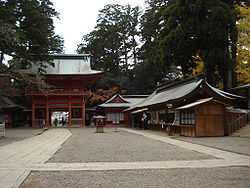Suigo-Tsukuba Quasi-National Park
| Suigō-Tsukuba Quasi-National Park | |
|---|---|
| 水郷筑波国定公園 | |
|
IUCN category V (protected landscape/seascape) | |
 | |
| Location | Honshū, Japan |
| Coordinates | 35°54′59.70″N 140°31′03.63″E / 35.9165833°N 140.5176750°ECoordinates: 35°54′59.70″N 140°31′03.63″E / 35.9165833°N 140.5176750°E |
| Area | 349.56 square kilometres (134.97 sq mi) |
| Established | March 3, 1953 |
| Governing body | Ibaraki Prefecture and Chiba Prefecture[1] |
Suigō-Tsukuba Quasi-National Park (水郷筑波国定公園 Suigō-Tsukuba Kokutei Kōen) is a quasi-national park in the Kantō region of Honshū in Japan. It is rated a protected landscape (category V) according to the IUCN.[2]
Geography
Suigō-Tsukuba Quasi-National Park covers an area in southeast Ibaraki Prefecture and northeast Chiba Prefecture. The park was established on March 3, 1953 to protect natural areas and cultural heritage of Lake Kasumigaura in Ibaraki Prefecture to the north, the Tone River basin on the border of Ibaraki Prefecture and Chiba Prefecture, and the areas around Cape Inubō and Byōbugaura in Chiba Prefecture to the south. In 1969 the areas around Mount Tsukuba and Mount Kaba in Ibaraki Prefecture, not adjacent to other areas of the park, were added to Suigō-Tsukuba.[3]
Administration
Like all quasi-national parks in Japan, the park is managed by the local prefectural governments.[1] Suigō-Tsukuba Quasi-National Park, which spans over two prefectures, is jointly administered by Ibaraki and Chiba prefectures.
Gallery
-
Mount Tsukuba viewed from Mount Hyōkyō
-

Rice-Transplanting Festival at the Katori Shrine
See also
External links
- Suigō-Tsukuba Quasi-National Park, World Database on Protected Areas(English)
- National Parks of Japan(English)
- 水郷筑波国定公園(Japanese)
References
- ↑ 1.0 1.1 "National Park systems: Definition of National Parks". National Parks of Japan. Ministry of the Environment of the Government of Japan. Retrieved 2012-02-28.
- ↑ "Suigō-Tsukuba Quasi-National Park". World Database on Protected Areas. United Nations Environment Programme, World Conservation Monitoring Center. Retrieved 2012-02-28.
- ↑ "Suigō-Tsukuba Kokutei Kōen (水郷筑波国定公園)". Nihon Daihyakka Zensho (Nipponika) (日本大百科全書(ニッポニカ). Tokyo: Shogakukan. 2012. Retrieved 2012-04-09.(Japanese)
| Wikimedia Commons has media related to Suigo-Tsukuba Quasi-National Park. |





